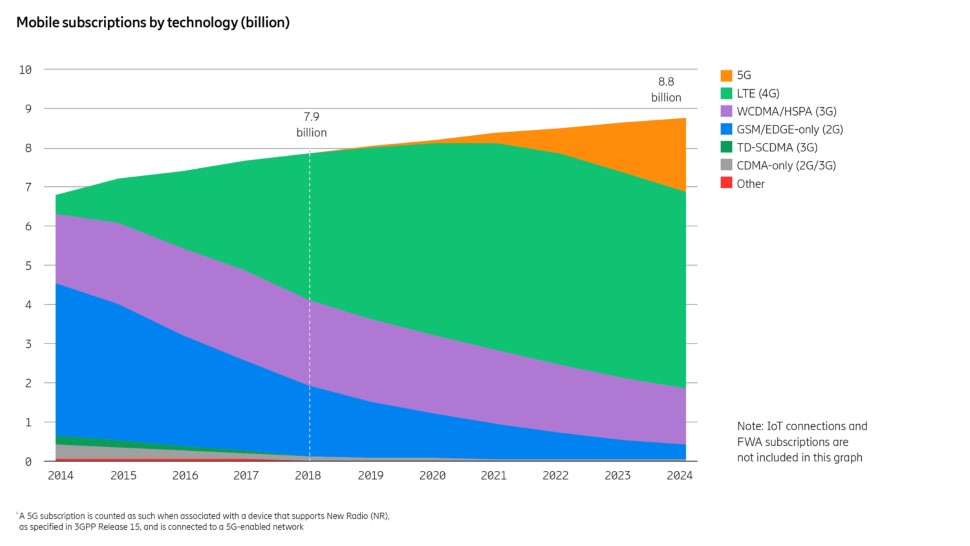Ericsson Expects Nearly 2B 5G Subs by 2024
STOCKHOLM—As wireless providers worldwide expand their rollout of 5G services over the next several years, one wireless vendor believes there will be 10 million subscriptions to the next-gen wireless standard by the end of 2019, with that number expanding to 1.9 billion by 2024, representing more than 20% of all mobile subscriptions.
According to Ericsson’s latest Mobility Report, most new 5G subscribers will be users trading up their 4G handsets to 5G-compatible devices, but by 2024, many young users in mature markets will get a 5G smartphone as their first device.

4G LTE subscriptions will peak at 5.3 billion subs by 2022 and start to decline but will remain the dominant wireless service with about 5 billion subs by 2024, according to the report.
The total number of smartphone subscriptions worldwide by the end of 2018 numbers 5.1 billion, 99% of which were for 3G or 4G with the overall number of subscriptions to reach 7.2 billion by 2024. Subscriptions for fixed broadband are expected to grow only 3% over the period with subscriptions for mobile PCs, tablets and routers to grow moderately, reaching 330 million within five years, according to the report.
As has been predicted for years by Cisco, video will dominate mobile data traffic for the foreseeable future, with video traffic expected to grow 34% annually up to 2024, representing nearly 75% of all mobile data traffic by then, up from 60% in 2018.
The main drivers for video traffic growth vary, according to Ericsson.
“Mobile video traffic growth is driven by the increase of embedded video in many online applications, growth of VOD streaming services in terms of both subscribers and viewing time per subscriber, and the perpetual evolution towards higher screen resolutions on smart devices,” Ericsson said. “All these factors have been influenced by the increasing penetration of video-capable smart devices.”
Get the TV Tech Newsletter
The professional video industry's #1 source for news, trends and product and tech information. Sign up below.
Spectrum sharing is expected to help facilitate faster 5G rollouts, the report said.
“A fast way to build coverage is to utilize existing frequency band used by today’s LTE networks,” Ericsson said. “By implementing spectrum sharing, service providers can run LTE and 5G traffic on the same bands. This enables them to provide 5G coverage quickly but requires device chipset support. Chipsets are currently in development and are anticipated to be in 5G commercial devices in late 2019.”
Geographically, the largest consumer of mobile data traffic is North East Asia (China) and India logs the highest average usage per smartphone. In terms of 5G subscriptions, North America is expected to lead the way with 270 million 5G subscriptions, representing more than 60% of all mobile subscriptions by 2024.
Total mobile data traffic continues to grow globally and is predicted to reach 131 exabytes by the end of 2024, the report said.
Tom has covered the broadcast technology market for the past 25 years, including three years handling member communications for the National Association of Broadcasters followed by a year as editor of Video Technology News and DTV Business executive newsletters for Phillips Publishing. In 1999 he launched digitalbroadcasting.com for internet B2B portal Verticalnet. He is also a charter member of the CTA's Academy of Digital TV Pioneers. Since 2001, he has been editor-in-chief of TV Tech (www.tvtech.com), the leading source of news and information on broadcast and related media technology and is a frequent contributor and moderator to the brand’s Tech Leadership events.

